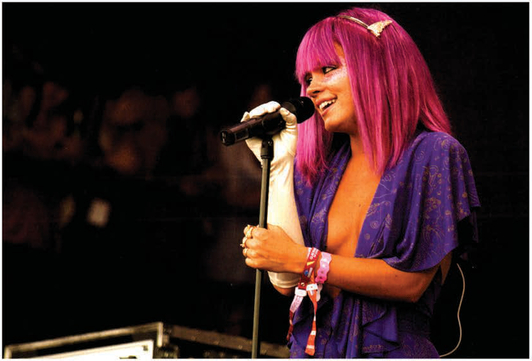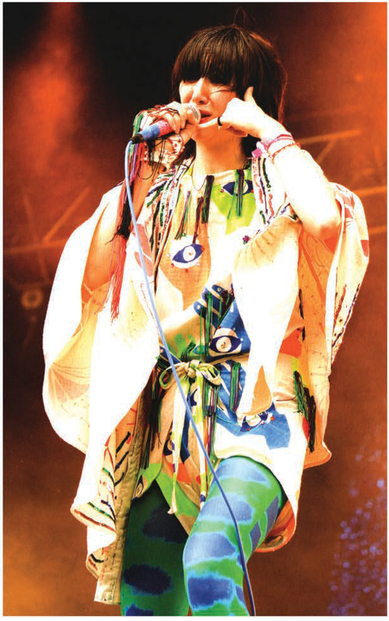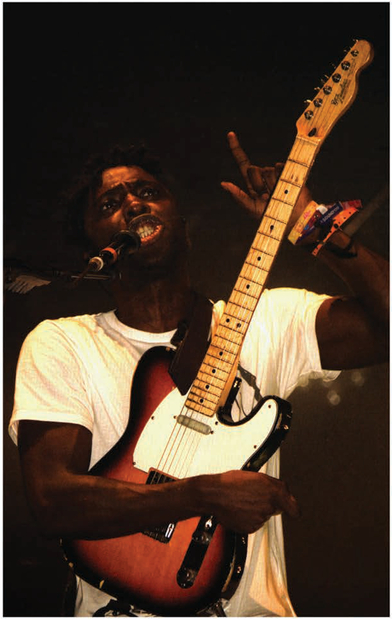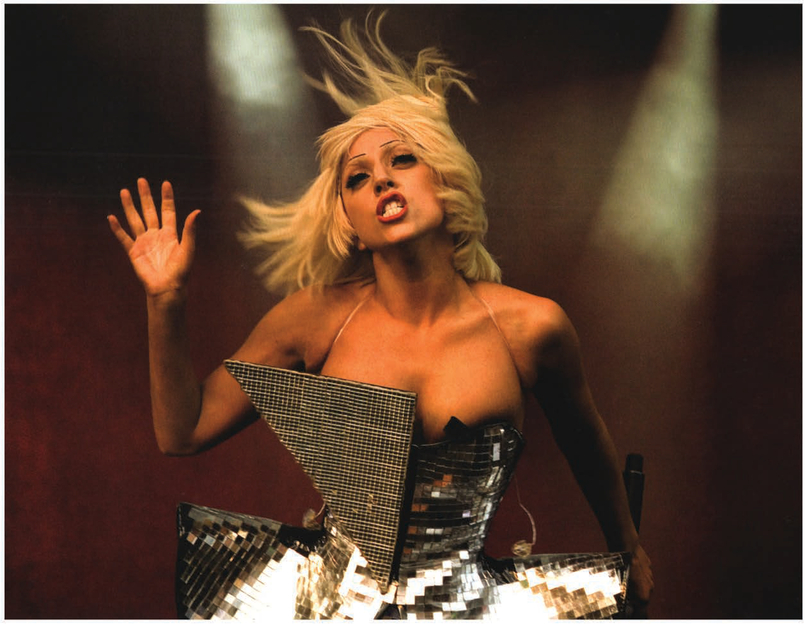39 Concerts
Performance and display
Ruby May Allcock
The Idea
Live music photography is fascinating-a perfect chance to take shots of people in their performance modes, displaying interesting character, high emotion, and energy-on top of which, gigs are great fun! With some preparation and experimentation, there is no reason why you can't get impressive results from less than high-end equipment,
Lady Gaga in Black-and-While I waited for the moment her arm was perfectly aligned with her costume
The Ingredients
- ▶ Any camera
- ▶ Flashgun (optional)
The Process
So you have a ticket or a press pass to a gig, but what about the kit? Can't afford the expense of a camera such as a Canon EOS-ID or a Nikon D3X? Well, I still use my first SLR camera-the Canon EOS-350D-which came onto the market in 2005. I was lucky enough to get a press pass for Glastonbury Festival (the largest outdoor music and performing arts festival in the world). Astounded by the amount of equipment everyone had, I felt daunted among the mass of 30 or so other photographers in the pit, holding only my 350D. I tried to ignore the fact that I was also the shortest there and could barely see above the highly built stage. (Note to self: next time bring stepladder or stool like the others!) But I ended up with shots I was really proud of.
Preparation
Before the gig it's always worth researching the artist(s) or band(s), Look at their websites and listen to their music. Watch videos and view other photos of them. This way you'll learn more about your subject(s) and how they act on stage. For example, Lady Gaga is one of the ultimate performers, with a haute-couture, showgirl image. Her movements are expressive and frenetic. Having done my research, I understood that I needed to capture this essence in her performance, and I made sure her clothing was an important part of the image, It may seem obvious, but another good tip is always to bring spare batteries and memory cards. They are easy to carry, and it is extremely frustrating if you run out of memory or power and miss an interesting or insane moment on stage.
Three-song rule
Most venues and acts follow the three-song rule in the photo pit (three songs and you're out), so you have to be quick off the mark. Position yourself well, watch the performance for a moment, and try not to panic. Don't frantically take a photo every second possible in the hope of getting one good shot-wait for the right lighting and the right moment on stage. Vocalists are often stuck in front of the microphone, which can be uninteresting, so wait for them to move away slightly before you shoot, take a picture of another member of the band instead, or maybe even a crowd shot.
ISO/shutter speed/apertures
For concert photography it's best to go for an aperture of f/2.8 or lower to allow more light in so that you can shoot at faster shutter speeds. As band members tend to move and jump around a lot, this is a key point that will help you capture a sharp image rather than an out-of - focus shot. A good, affordable lens that is great in these situations is the Canon 50mm f/1.8.The aperture goes as low as you need, it doesn't weigh much, and it produces a really sharp image. The only slight problem is that it is a fixed focal length lens so, as you are not able to zoom with it, you need to get as close as possible to the performers. Set your ISO to BOO or 1600; this is best for low-light photography as it means you can use a faster shutter speed. However, sometimes using an ISO as high as 1600 will increase the digital noise/graininess of images, with color speckles appearing where there shouldn't be any. This is usually unavoidable, but again, it all depends on the available lighting. If there is a lot of light, you can set your ISO lower, resulting in less noise.
I normally take my photos on the Aperture Priority setting, With this you can set your desired aperture as well as the ISO, and the camera will automatically calculate the shutter speed. As using a low aperture is important for taking high-speed music photos, this mode makes the most sense to me, However, it can

Rob Swire. Pendulum A flash action shot The symmetry of Rob's arms aligned with the wings on his T-shirt

Bruce Springsteen fans I took this shot of Bruce Springsteen fans in the crowd white I was waiting for an act to come on stage

Lily Allen This shot was taken during a daytime performance, using Shutter Priority mode. There was a lot of available light, so I could use a fast shutter speed.
depend on what the stage lighting is like at the gig you are attending. For example, when I shot my photos at Glastonbury during the daytime, I didn't need the aperture to be low because there was a lot of light available. This meant I could use a faster shutter speed, so I set my camera to Shutter Priority instead. This allows you to set your desired shutter speed, and the camera calculates which aperture to use.
Flash
Some photographers dislike using flash, and it's usually best to keep it to a minimum-it can distract the performers and certain venues don't allow it. However, if the stage Sighting isn't great and your photos aren't working for you, or if you don't own a lens with an aperture that is low enough, using flash can be a good way to solve these problems, and it can be really effective, I recommend investing in a flashgun rather than using your built-in flash, as this allows you to use a variety of settings to produce different effects. It also means you are in charge of how much light you let out to compensate for the level of the stage lighting.
So, just get stuck in and try it. Don't be embarrassed about your kit. You don't need the best technology to take a great photo. Preparation, a little technical knowledge, familiarity with your equipment, and a lot of front can get you fantastic images that will compete with those of the boys with the big lenses!

Karen 0, the Yeah Yeah Yeahs To make the most of the atmospheric orange Lighting, which complemented her costume, I shot without flash.

Bloc Party I used flash in this shot to reflect off and accentuate the white T-shirt of Kele Okereke. frontman of Bloc Party


